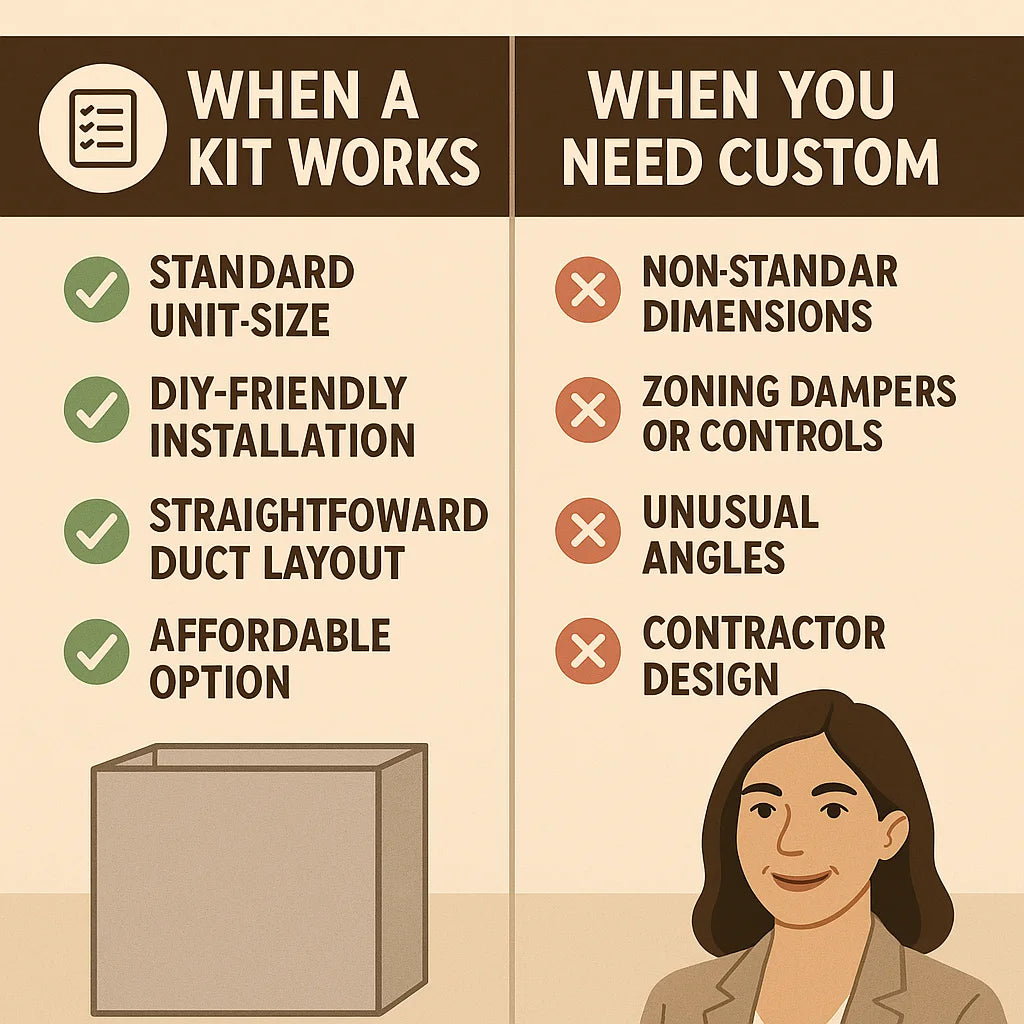🎯 Introduction
Your HVAC system is only as good as the airflow that moves through it. And at the heart of that airflow sits a critical, often-overlooked component: the plenum box.
The plenum connects your furnace or air handler to the ductwork, acting like a “traffic hub” that distributes air evenly throughout your home. Without the right plenum setup, your system will strain, efficiency drops, and comfort suffers.
When replacing or upgrading, many homeowners face a key question:
👉 Do I need a custom plenum, or will a pre-fabricated plenum kit do the job?
The truth is, both have their place. In this guide, we’ll explore the differences, benefits, costs, and real-world scenarios so you can decide whether a plenum kit or a custom plenum is best for your home.
🔎 What Is a Plenum Kit?
A plenum kit is a pre-sized, ready-to-install metal box, designed to fit most standard residential HVAC units.
📦 Features of Plenum Kits
-
Standard sizing (e.g., 20x20x36 kit fits common 3-ton units).
-
Pre-formed connections for attaching duct collars.
-
Smooth sheet metal construction for maximum airflow.
-
Can be insulated externally for energy efficiency.
✅ Advantages of Plenum Kits
-
DIY-friendly: Anyone with basic skills can install with the right tools.
-
Cost-effective: Less expensive than custom fabrication.
-
Time-saving: Ready-to-use, no need for special sheet metal cutting.
-
Reliable sizing: Designed to match the airflow needs of common HVAC units.
🚫 Limitations of Plenum Kits
-
Fixed dimensions → may not fit unusual systems.
-
Limited flexibility for adding extra features (like zoning dampers).
-
Works best with straightforward duct layouts.
📖 Further Reading: Energy.gov – HVAC Components Explained
🛠️ What Is a Custom Plenum?
A custom plenum is fabricated by an HVAC contractor or sheet metal shop to fit your system’s unique requirements.
📏 Features of Custom Plenums
-
Built to exact specifications (dimensions, duct connections, transitions).
-
Can integrate special features like zoning dampers or unique angles.
-
Typically crafted from heavy-gauge sheet metal.
✅ Advantages of Custom Plenums
-
Perfect fit: Ideal for non-standard or older HVAC systems.
-
Design flexibility: Can accommodate unusual duct layouts.
-
Advanced functionality: Supports zoning systems or complex airflow needs.
🚫 Limitations of Custom Plenums
-
Higher cost: Custom labor and materials increase the price.
-
Longer lead time: Must be fabricated, often adding days or weeks.
-
Requires pro installation: Not DIY-friendly.
📖 Further Reading: ACCA – Air Distribution System Design
⚖️ Plenum Kit vs. Custom Plenum: Key Comparisons
| Factor | Plenum Kit | Custom Plenum |
|---|---|---|
| Cost | Lower upfront ($150–$300) | Higher ($400–$1,000+) |
| Installation | DIY-friendly | Pro installation required |
| Fit | Best for standard systems (e.g., 20x20x36) | Best for non-standard sizes |
| Durability | Long-lasting sheet metal | Same or higher, depending on gauge |
| Flexibility | Limited (fixed size) | Fully customizable |
| Lead Time | Immediate (in stock) | Requires fabrication |
| Features | Basic airflow | Can add zoning, custom angles, transitions |
🏡 When a Kit Works Best
Most homeowners can use a plenum kit without issues.
✅ A Kit Is Ideal If:
-
Your HVAC system is standard size.
-
You want a DIY-friendly solution.
-
Your ductwork layout is straightforward.
-
You’re replacing an existing plenum of similar dimensions.
-
You want an affordable option without compromising quality.
🏗️ When You Need a Custom Plenum
Some situations require more than a standard kit.
✅ Custom Plenums Are Needed If:
-
Your HVAC unit has non-standard dimensions.
-
You’re upgrading to a zoned system with multiple dampers.
-
Your ductwork requires special angles or transitions.
-
You’re working with an older home that has unique HVAC challenges.
-
A contractor recommends it for airflow optimization.
⚡ Cost Considerations
💵 Plenum Kit Costs
-
Material cost: $150–$300.
-
DIY installation saves labor costs.
-
Insulation wrap adds $50–$100.
💵 Custom Plenum Costs
-
Fabrication: $400–$1,000+ depending on complexity.
-
Labor: $300–$600 for professional installation.
-
Best for complex or high-performance systems.
📖 Further Reading: ACHR News – HVAC Installation Costs
🧰 Maintenance & Longevity
Plenum Kits
-
Durability: 20–30+ years.
-
Maintenance: Easy to seal, insulate, and inspect.
-
Best practice: Reseal seams with mastic every few years.
Custom Plenums
-
Durability: 25–40 years depending on gauge.
-
Maintenance: Similar upkeep, though harder to replace.
-
Best practice: Annual inspections for leaks or condensation.
📖 Further Reading: EPA – Duct & Plenum Maintenance
📊 Real-World Case Studies
Case 1: Standard System with Kit
-
Homeowner replaces old plenum with 20x20x36 kit.
-
Uses foil tape and mastic for sealing.
-
Saves $500 vs. custom fabrication.
-
Airflow improves, energy bills drop by 15%.
Case 2: Zoned System with Custom Plenum
-
Homeowner installs a zoning system with 3 dampers.
-
Requires custom plenum with multiple takeoffs.
-
Cost: $800 fabrication + $500 installation.
-
Result: Perfectly balanced airflow, tailored comfort in each zone.
Case 3: Older Home Retrofit
-
1950s home with unusual furnace dimensions.
-
Plenum kit doesn’t fit.
-
Custom plenum built to size.
-
Prevented costly duct rework and ensured system efficiency.
✅ Conclusion
So, do you need a custom plenum or will a kit work?
-
For most homeowners, a plenum kit (like the 20x20x36) offers the best combination of affordability, durability, and DIY-friendly installation.
-
For non-standard, zoned, or complex systems, a custom plenum is worth the investment for airflow performance and system longevity.
In the Next Topic we will know more about: Boosting Indoor Air Quality: How Your Plenum Affects Filtration and Circulation







